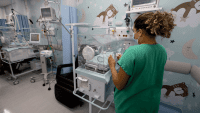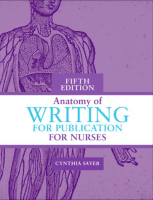ANA, nurses nationwide work to improve transitions in care
Mary Maryland, PhD, APRN,BC, ANP, has had to rely on good old-fashioned nursing ingenuity to ensure that her 84-year-old father will have the care he needs if he’s suddenly transferred from his long-term care facility to a hospital.
She’s fashioned a plastic ID pocket badge that he wears around his neck with his name on the front and important healthcare information—including her name as an emergency contact—on the back. Maryland took this measure after an incident in which her father, who has dementia, ended up in a hospital with no ability to relate this vital information.
She believes that having easily accessible, standardized electronic health records would go a long way toward helping to create seamless transitions in care—be it when a patient moves from acute to long-term care or from the emergency department to a med-surg unit.
“But we don’t have that technology in place,” says Maryland, an Illinois Nurses Association member and ANA board member. “And, unfortunately, there are many places where fragmented care can occur as people move through the healthcare system. It’s not that we, as healthcare professionals, don’t have good intentions. Sometimes it’s the sheer volume of work we have, and sometimes patients, family members, and other providers aren’t available or unintentionally don’t give us the information we need to provide appropriate care.”
And sometimes it’s a systems issue. “The healthcare system has evolved in such a way that patients are seen by many physicians, nurses, and other health team members,” says Mary Naylor, PhD, RN, FAAN, a transitional care expert and Pennsylvania State Nurses Association member. “Unfortunately, few of these clinicians have a sense of the patient as a whole, and patients and family caregivers must navigate a disjointed system to have their needs met.”
Fortunately, Naylor, ANA nurse leaders, and other RNs nationwide are working on efforts to close the gaps in care that can occur during patient discharges or transfers. For example, Naylor and ANA President Rebecca M. Patton, MSN, RN, CNOR, serve on a National Quality Forum (NQF) committee that is developing a measurement framework for care over the course of a chronic episode of illness.
Making strides
Since Fall of 2006, Jill Murray, MSN, RN, has been part of an innovative program that’s designed to smoothly transition older hospitalized patients with multiple chronic conditions back to their homes. The program’s equally important goal is to prevent the typical hospital readmissions that plague this patient population by addressing the root causes of their health problems.
Murray is not a discharge planner or traditional case manager; rather, she is a transitional care nurse with Kaiser Permanente, San Francisco Medical Center. “In discharge planning and most nursing roles, you are looking at a ‘snapshot’ in time of a patient’s hospital stay,” Murray says. “As a transitional care nurse, it’s like you’re watching a film. You are able to learn much more about that patient—the circumstances or behaviors that may affect his well-being and health—when you are with him every step of the way in the healthcare system.”
Murray’s role is part of an effort to apply the research-based transitional care model, developed by Naylor and her team at the University of Pennsylvania (Penn) School of Nursing, in real-world settings. Kaiser Permanente and the Aetna Corporation agreed to partner with the Penn team 2 years ago to determine if this model of care effectively meets the clinical needs of their high-risk elder patients and is cost-effective.
Under the transitional care model, the same APRN or RN delivers and coordinates care across all settings using evidence-based protocols to achieve long-term outcomes. For example, the transitional care nurse conducts a comprehensive assessment of the needs of the patient and family caregivers, follows the patient from acute care to discharge, collaborates with healthcare team members and caregivers, and facilitates the handoff to the primary care provider. The nurse implements the care plan through home visits and phone calls, and is available 7 days a week, for several months.
Having an actual transitional care plan can really make a difference. For example, during an initial home visit, Murray successfully intervened with a patient who she recognized was deteriorating cognitively. “The patient was very socially savvy, and she was able to fool people into thinking she was fine when she was in the hospital,” Murray explains. “It took a lot of work, but I was able to get her 24-hour care. And as a result, there was a good patient outcome.”
Deanna Bloom, BSN, RN, a transitional care nurse at Kaiser’s Summit Hospital in Oakland, California, also sees the potentially life-saving effects of transitional care. “I went to see a patient who enrolled for the service after being discharged from a skilled nursing facility,” Bloom says. “When I got to her home, her niece told me that there was a discrepancy in her aunt’s medications. So her aunt decided not to take any of her meds, including one for her heart, until I got there.”
So far, some 2,000 patients have received care through programs using the transitional care model; the University of Pennsylvania healthcare system just adopted this model as part of their delivery system.
Keeping care on track
“Care coordination—which includes having solid patient handoffs between units, for example—has risen to the top as an important issue these days, because of the heightened interest and research on patient safety and quality,” says Gerri Lamb, PhD, RN, FAAN, an associate professor at Emory University’s School of Nursing and Arizona Nurses Association member. “If you think of patients as being on a conveyor belt from the time they walk in the door of a hospital to the time they leave, it’s the nurses who do everything they can to keep those patients moving along safely and in a timely manner.”
For the past 2 years, Lamb has led a research team that’s spent hundreds of hours observing and interviewing nurses and patients to identify the many ways RNs coordinate patient care. Their research is funded by the Robert Wood Johnson Foundation Interdisciplinary Nursing Quality Research Initiative. “We took all those activities and developed a new definition of nurse care coordination,” she says. That definition focuses on nurses’ actions with patients, their families, and members of the healthcare team to “manage and correct the sequence, timing, and effectiveness of patient care from hospital admission to hospital discharge.”
Lamb and her research team then identified core care coordination activities, such as those that take place during patient handoffs between shifts or between units and those that involve mobilizing team members to address a patient-care issue. Using these core activities, they developed a tool that recently was sent to more than 1,000 nurses to determine whether it accurately captures the activities nurses perform to ensure smooth patient care.
The tool ideally will provide concrete evidence of the crucial role nurses play in ensuring positive patient outcomes as they move through the healthcare system, as well as highlight areas where care coordination can be improved.
Meanwhile, in Delaware, Paula Tomanovich, BSN, RN,BC, heads an 11-bed, med-surg inpatient unit at Wilmington Hospital specifically designed for patients who are at least 70 years old. Nurse-led interdisciplinary team meetings are an essential part of ensuring both a smooth length of stay and transition to home or another facility.
“Usually a day before discharge, the nurse will print out a discharge form that includes medications and other orders,” Tomanovich says. As part of this process, the physician must check off the medications and ensure they’re accurate. This form then is given to patients and their families, and instructions are reinforced.
Furthermore, if a patient is going to a nursing home, additional information is included in the discharge packet, such as a brief history of the person’s hospital stay, including any skin issues, for example. Nurses also are required to call the nursing home to provide a formal report to caregivers there.
“As a whole, I think we are getting better at patient handoffs, whether in communicating facility to facility or provider to provider,” Tomanovich says. “And we definitely are more aware of the importance of medication reconciliation.”
In terms of the latter, ANA Chief Executive Officer Linda Stierle, MSN, RN, CNAA,BC, chairs a working group on medication reconciliation initiated by NQF. Among its goals are to harmonize medication reconciliation measures so they are “portable” across all care settings and accelerate the adoption of electronic data standards.
Adds Maryland, “Imagine if we could all have a flash drive with our pertinent healthcare information. We could share critical health data almost instantly, without omissions, with any provider.”
That said, she believes that nurses must educate the public about the importance of having a concise, updated healthcare history written out on paper that’s easily accessible, especially in an emergent situation. “We need to educate the public—especially those who care for dependent seniors who may be in frail health or have cognitive impairments—to be more proactive, so they or their loved ones can get timely and safe care when needed in every healthcare setting.”
Susan Trossman is the senior reporter in ANA’s Communications Department.

















